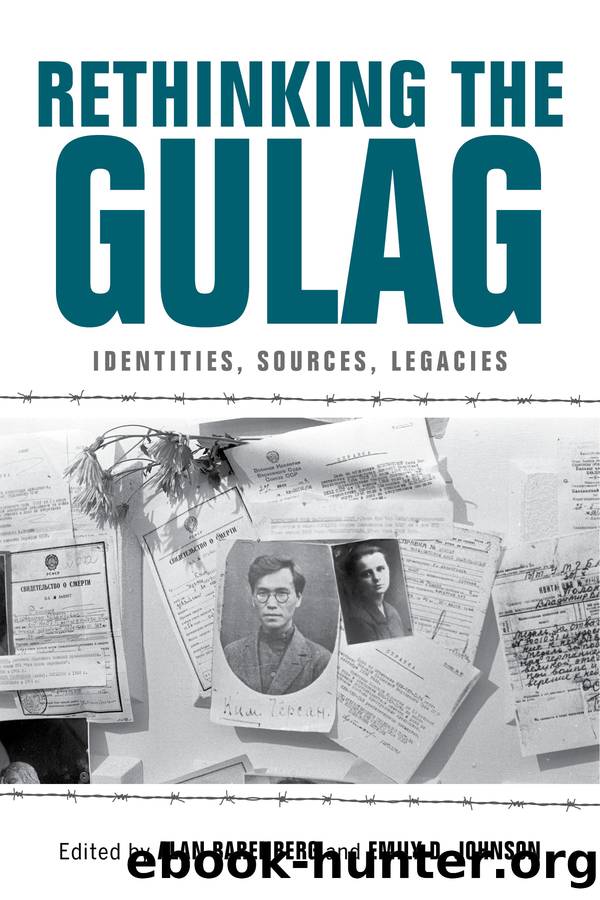Rethinking the Gulag by Alan Barenberg;Emily D. Johnson;

Author:Alan Barenberg;Emily D. Johnson;
Language: eng
Format: epub
ISBN: 9780253059598
Publisher: Indiana University Press
Published: 2021-10-25T00:00:00+00:00
TITLES
While titles are often formulated with significant input from editors and others, they nevertheless play a crucial role in framing the text and directing the reader. Removing duplicates as well as headers and subtitles obviously inserted by editors of collections leaves a list of 1,337 titles, forming a corpus of 5,871 words overall and 2,814 unique words. The vocabulary of titles overall emphasizes optimism as much as the negative impact of the Gulag and suggests a desire to avoid sensationalism. Notably, life (zhiznâ) is the second most common noun (after memoirs) in this micro-corpus, featuring eighty-five times in titles, with no negative modifiers. Death (smertâ, mertvyi), by comparison, appears only twenty times. Positive terms such as joy (radostâ), light (svet), hope (nadezhda), and happiness (schastâe/schastlivostâ) occur four, eleven, two, and seven times respectively. These may be small numbers, but they are similar to those alluding to the overwhelming suffering experienced in the camps, which we might expect to be more prominent. Hunger (golod) appears twice and cold (kholod) four times; suffering (stradanie) itself has three occurrences, as does grief/woe (gore); sorrow (skorbâ) has five, grief/sorrow (pechalâ) four, pain (bolâ) five, and bitter (gorâkii) six. Words denoting terror and fear have a minimal presence: fear/terror (strakh) and to fear (boiatâsia) both appear twice, the latter prefaced with a negative pronoun (no other negatives modify subsequent terms discussed); other synonyms for fear are absent. Perhaps most strikingly, there are only fifteen references to Stalin/-ist in titles, seven to Article 58âthe notorious article of the Stalinist penal code defining counterrevolutionary crimesâand four to the various incarnations of the Soviet security apparatus.
Breaking down the titles in this way enables us to identify some overall patterns, but viewing them as individual units is also integral to understanding their modes of framing the texts. Reading the titles thematically, I identified four fundamental categories. Five hundred fourteen directly advertise their status as Gulag memoirs while 450 allude to the subject matter indirectly (referring, for example, to suffering or memory, but without identifying the Gulag as the source of these). There are 103 poetic titles apparently unconnected to the main subjectâfor example, Alievaâs âThe Scent of Violetsâ (Zapakh filiaki).10 Two hundred seventy-two neutral titles encompass generic definitions, such as the ubiquitous My Memoirs (Moi vospominaniia), and references to people, notably family members, in both cases without further elaboration. I will return to the role of generic markers below.
As table 8.1 shows, direct references to the Gulag take a number of forms.11 Aspects of the authorâs case or sentence, such as Mindlinâs Full Face and Profile: [Article] 58â10 (Anfas i profilâ: 58â10), often elide with those that refer to time, as in Zoia Marchenkoâs Seventeen Years on the Islands of the Gulag (Semnadtsatâ let na ostrovakh GULAGa). But reference to the spatial dimension alone is much more common. A distinctive geography arises, as journeys to or between camps emphasize the dramatic change or distance involvedâfor example, in âNew YorkâMoscowâSiberia under Convoyâ (Nâiu-IorkâMoskvaâSibirâ po etapu) by Blok-Baers. Alongside Kolyma (twenty-eight),
Download
This site does not store any files on its server. We only index and link to content provided by other sites. Please contact the content providers to delete copyright contents if any and email us, we'll remove relevant links or contents immediately.
| African | Asian |
| Australian & Oceanian | Canadian |
| Caribbean & Latin American | European |
| Jewish | Middle Eastern |
| Russian | United States |
4 3 2 1: A Novel by Paul Auster(11788)
The handmaid's tale by Margaret Atwood(7447)
Giovanni's Room by James Baldwin(6808)
Asking the Right Questions: A Guide to Critical Thinking by M. Neil Browne & Stuart M. Keeley(5355)
Big Magic: Creative Living Beyond Fear by Elizabeth Gilbert(5351)
Ego Is the Enemy by Ryan Holiday(4954)
On Writing A Memoir of the Craft by Stephen King(4661)
The Body: A Guide for Occupants by Bill Bryson(4580)
Ken Follett - World without end by Ken Follett(4442)
Bluets by Maggie Nelson(4259)
Adulting by Kelly Williams Brown(4231)
Eat That Frog! by Brian Tracy(4147)
Guilty Pleasures by Laurell K Hamilton(4116)
White Noise - A Novel by Don DeLillo(3829)
The Poetry of Pablo Neruda by Pablo Neruda(3813)
Fingerprints of the Gods by Graham Hancock(3731)
Alive: The Story of the Andes Survivors by Piers Paul Read(3728)
The Book of Joy by Dalai Lama(3694)
The Bookshop by Penelope Fitzgerald(3616)
